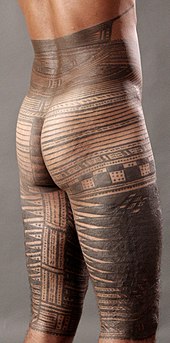Main article: History of tattooing
Preserved tattoos on ancient mummified human remains reveal that tattooing has been practiced throughout the world for many centuries.[21] The Ainu, an indigenous people of Japan, traditionally had facial tattoos, as did the Austroasians. Today, one can find Atayal, Seediq, Truku, and Saisiyat of Taiwan, Berbers of Tamazgha (North Africa), Yoruba, Fulani and Hausa people of Nigeria, and Māori of New Zealand with facial tattoos.[1][22] Tattooing was popular among certain ethnic groups in southern China, Polynesia, Africa, Borneo, Cambodia, Europe, Japan, the Mentawai Islands, MesoAmerica, New Zealand, North America and South America, the Philippines, Iron Age Britain, and Taiwan.[citation needed] In 2015, scientific re-assessment of the age of the two oldest known tattooed mummies, identified Ötzi as the oldest currently known example. This body, with 61 tattoos, was found embedded in glacial ice in the Alps, and was dated to 3,250 BC.[21][23]
It is a myth that the modern revival of tattooing stems from Captain James Cook's three voyages to the South Pacific in the late 1700s.[24] Certainly, Cook's voyages and the dissemination of the texts and images from them brought more awareness about tattooing (and, as noted above, imported the word "tattow" into Western languages), but Europeans have been tattooed throughout history. On Cook's first voyage in 1768, his science officer and expedition botanist, Sir Joseph Banks, as well as artist Sydney Parkinson and many others of the crew, returned to England with tattoos, although many of these men would have had pre-existing tattoos. Banks was a highly regarded member of the English aristocracy that had acquired his position with Cook by co-financing the expedition with ten thousand pounds, a very large sum at the time. In turn, Cook brought back with him a tattooed Raiatean man, Omai, whom he presented to King George and the English Court. On subsequent voyages other crew members, from officers, such as American John Ledyard, to ordinary seamen, were tattooed.
The first documented professional tattooist in Britain was established in the port of Liverpool in the 1870s. In Britain tattooing was still largely associated with sailors[25] and the lower or even criminal class,[26] but by the 1870s had become fashionable among some members of the upper classes, including royalty,[2][27] and in its upmarket form it could be an expensive[28] and sometimes painful[29] process. A marked class division on the acceptability of the practice continued for some time in Britain.[30] Recently a trend has arisen marketed as 'Stick and Poke' tattooing; primitive figures are permanently inscribed by the user himself after he obtains a 'DIY' kit containing needles, ink and a collection of suggestions.[31]
United States[edit]
As most tattoos in the U.S. were done by Polynesian and Japanese amateurs, tattoo artists were in great demand in port cities all over the world, especially by European and American sailors. The first recorded professional tattoo artist in the United States was a German immigrant, Martin Hildebrandt.
He opened a shop in New York City in 1846 and quickly became popular during the American Civil War among soldiers and sailors of both Union and Confederate militaries. Hildebrandt began traveling from camp to camp to tattoo soldiers, making his popularity increase, and also giving birth to the tradition of getting tattoos while being an American serviceman. Soon after the Civil War, tattoos became fashionable among upper-class young adults. This trend lasted until the beginning of WWI. The invention of the electric tattoo machine caused popularity of tattoos among the wealthy to drop off. The machine made the tattooing procedure both much easier and cheaper, thus, eliminating the status symbol tattoos previously held, as they were now affordable for all socioeconomic classes. The status symbol of a tattoo shifted from a representation of wealth, to a mark typically seen on rebels and criminals. Despite this change, tattoos remained popular among military servicemen, and the tradition continues today. Over time tattoos have become increasingly popular in the U.S., and according to a study in 2006; nearly 25 percent of Americans between the ages of eighteen and fifty have one or more tattoos.[32]
Since the 1970s, tattoos have become a mainstream part of Western fashion, common among both sexes, to all economic classes, and to age groups from the later teen years to middle age. For many young Americans, the tattoo has taken on a decidedly different meaning than for previous generations. The tattoo has "undergone dramatic redefinition" and has shifted from a form of deviance to an acceptable form of expression.[33] In 2010, 25% of Australians under age 30 had tattoos.[34][not in citation given][dubious ]




Post a Comment